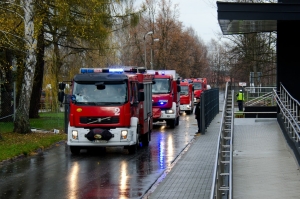Anti-terrorist exercise in Świerk
19-11-2015
The scenario of the exercise was that some radioactive material was released from the MARIA nuclear reactor in result of a terrorist attack. Objectives of the exercise included to check readiness of the relevant services/offices/forces (including reactor security forces, NCBJ dosimetrists, NCBJ technical squads, National Atomic Energy Agency’s Radiation Emergency Centre, Otwock County Police Department, Polish Police Headquarters’ Duty Officer, Polish Police Headquarters’ Bureau of Counter-Terrorist Operations) to react to such a hypothetical threat.
Colonel Sławomir Kleszcz, Chief of Defence Against Weapons of Mass Destruction in Polish Armed Forces General Command, Commander-in-Chief of the exercise, points out that emergency squads/brigades must take into account radiation emergencies and regularly verify their readiness to mutually co-operate in order to adequately react to them even if such emergencies are among least probable threats of public safety in Poland. „In any radiation emergency situation a possibly prompt notification of proper authorities, quick arrival of various emergency squads the site, and their professional co-operation in limiting negative consequences for people and environment as far as possible is what counts most. We must regularly train such skills” – said Col. Kleszcz.
According to scenario of the game played in NCBJ, a group of armed terrorists has burst into the institute premises. As soon as the incident was noticed by a patrol of the Institute security guard, suitable procedures were invoked. Emergency squads, including anti-terrorist forces, arrived to Świerk within a few minutes after the alert was triggered. According to the scenario, next a strong explosion from the reactor building was heard. It was a decisive factor for the anti-terrorist troops commander to command an immediate assault even if there was a risk of a radioactive contamination for his people. As soon as the action was finished, Świerk dosimetrists thoroughly checked all persons which might have been contaminated and started to decontaminate the premises.
„Luckily it was only a drill. However, all security-related matters must be treated as extremely important since we live in a very insecure world” – said Professor Krzysztof Kurek, NCBJ Director General. „Security is an absolute priority for the entire nuclear branch. Besides multiple reactor safety systems, expert risk analyses, highly professional reactor operators, and physical protection of nuclear facilities, the topic includes also application of nuclear technologies to improve national safety. Innovative Hi-Tech systems under development in our Institute may be an excellent example”.
NCBJ has been developing nuclear-based technologies and instruments capable to improve security for many years. Neutron activation-based technology makes possible to determine chemical composition of remotely scanned objects in order to identify hazardous substances (toxics, explosives etc.). That technology has been applied in the SWAN mobile system capable to detect hazardous substances: the scanned object is irradiated with a beam of neutrons generated in a machine called “neutron generator”, the neutron-induced gamma rays (“fingerprints” of atoms present within the object) are detected and analysed by suitable software to identify hazardous substances. CANIS, another innovative radiographic system developed in Świerk is capable to scan cargo containers in order to detect illegally trafficked objects/people. Other security-related systems currently developed by some European research consortia of which NCBJ is a member include the MODES SNM mobile modular system to detect radioactive substances/nuclear materials of special importance and the TAWARA RTM system to monitor contamination of water in municipal water supply systems.
The Patrol-15 games was played between November 17 and 19 in 6 places in Poland. It was a test of readiness of the KSWSiA Contamination Detection & Alerting system. In individual episodes of the test relevant services/institutions had to react to simulated chemical, biological and/or radioactive contamination. Resources/task forces subordinated to six Ministers (Defence, Home Office, Health, Agriculture, Environment, Infrastructure & Development) and Governors (Voivodes) have been engaged.
The KSWSiA system was set up by Regulation of the Council of Ministers issued on January 7, 2013 with the aim to co-ordinate operation of Contamination Detection & Alerting systems implemented in individual Government departments if any real contamination happens. The system is supervised by Minister of Defence assisted by the military Centre of Contamination Analyses (COAS), and acting in cooperation with Ministers of Internal Affairs (Police, Fire Brigades), Health, Public Administration, Agriculture, Maritime Economy, Environment, National Security Centre, National Atomic Energy Agency. That helps to react to any threat in a comprehensive and harmonized way, while decision makers may optimally use all available resources.





